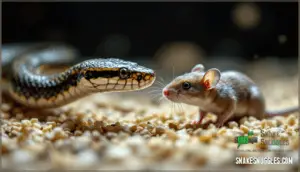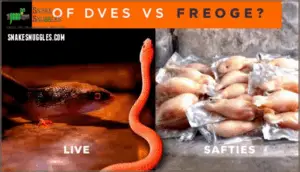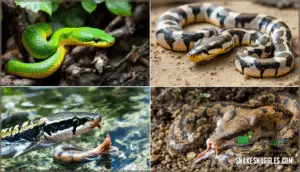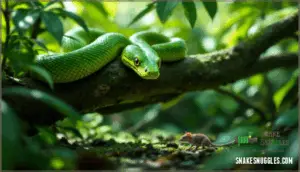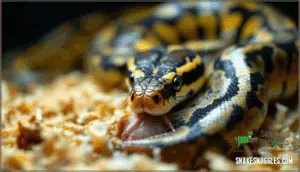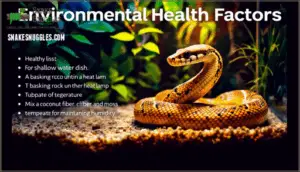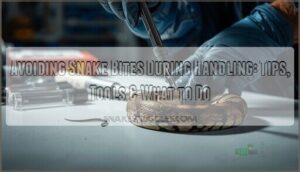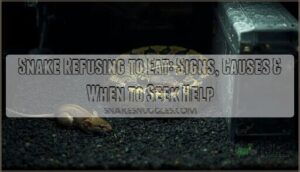This site is supported by our readers. We may earn a commission, at no cost to you, if you purchase through links.
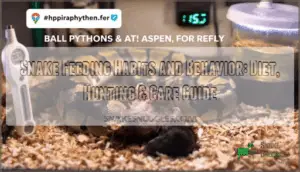
Wild snakes don’t eat on our timetables. They respond to temperature, prey availability, and seasonal rhythms hardwired into their DNA. In captivity, you’re managing those variables, and small mistakes—overfeeding, wrong temperatures, excessive interaction—cascade into digestive problems or refusal to eat.
Learning how snakes hunt, consume prey, and process meals helps you make better decisions about feeding frequency, prey selection, and environmental setup.
Table Of Contents
- Key Takeaways
- Snake Feeding Frequency
- Snake Diet and Prey Selection
- Hunting Tactics and Strategies
- Captive Snake Feeding and Husbandry
- Snake Health and Environmental Factors
- Frequently Asked Questions (FAQs)
- How do snakes act when hungry?
- How do snakes act after eating?
- How many times a day do snakes eat?
- Why do snakes eat so infrequently?
- How do snakes chew their food?
- What sounds do snakes make while feeding?
- Can snakes regurgitate meals when threatened?
- Do snakes drink water?
- How long can snakes survive without eating?
- How do snakes locate prey in darkness?
- Conclusion
Key Takeaways
- Feeding frequency depends on age, size, and species—hatchlings eat weekly, juveniles every 7-10 days, and adults every 10-14 days, with metabolism slowing dramatically during seasonal brumation periods of 3-5 months.
- Prey size should match your snake’s body width at its thickest point (about 10% body weight), and frozen prey is safer than live options, eliminating injury risks and disease transmission while retaining 95-98% nutritional value.
- Environmental factors like temperature (75-85°F ideal), humidity levels, and stress from excessive handling or poor enclosure setup directly control digestion efficiency and can trigger feeding refusal or regurgitation.
- Snakes are obligate carnivores with species-specific dietary needs—ball pythons require rodents exclusively, garter snakes need fish or amphibians, and overfeeding causes obesity with fat deposits reaching 18-22% body weight compared to wild specimens.
Snake Feeding Frequency
You won’t feed your snake the same way every week of its life. Several factors determine how often your snake needs to eat, from its age and size to the time of year.
Let’s look at what influences your snake’s feeding schedule.
Factors Influencing Feeding Frequency
When you’re trying to figure out how often to feed your snake, you’ll quickly discover that there’s no one-size-fits-all answer—it all depends on a mix of biological and environmental factors working together. Metabolic rate tops the list, since your snake’s body temperature directly controls how fast it digests food.
Prey availability and hydration levels also shift feeding frequency, while the shedding cycle temporarily reduces appetite. Seasonal variations trigger natural changes in your snake’s feeding schedule, especially during cooler months.
Even gut microbiome health influences digestion efficiency, affecting how often your snake needs its next meal.
Age and Size Considerations
Your snake’s age and size work hand-in-hand to determine its feeding schedule, with younger reptiles eating far more frequently than their adult counterparts. Hatchling diets focus on weekly meals to fuel rapid development, while juvenile portions every 7-10 days support ongoing growth stages. As snakes reach maturation stages, adult frequency drops to every 10-14 days since growth rates naturally slow. Size correlation matters too—larger adult snakes can wait longer between feedings due to decreased metabolic demands.
- Hatchlings need weekly feedings to support explosive early growth rates
- Juvenile snakes require meals every 7-10 days as they develop
- Adult snakes generally eat once every 10-14 days
- Prey size limits must match your snake’s width at the thickest body point
- Growth stages directly influence how much energy your snake needs
Species-Specific Feeding Patterns
Each snake species has evolved distinct dietary specializations shaped by evolutionary pressures and habitat. Ball pythons eat every 1-2 weeks on mice and small rats, reflecting their ambush lifestyle. Corn snakes feed more actively every 7-10 days, consuming mice and birds. Boa constrictors consume larger prey like rabbits every 2-4 weeks, with digestion taking over 10 days. King snakes show striking prey preferences, eating other snakes alongside rodents every 7-14 days.
Snakes experienced a period of ecological diversification after the Cretaceous-Paleogene extinction event.
These species-specific needs directly influence feeding practices in captivity and have conservation implications for understanding ecosystem roles.
Seasonal Changes and Brumation
As temperatures drop and daylight fades, snakes respond by dramatically altering their feeding habits—sometimes refusing food for months at a time. This process, called brumation, is triggered by shorter days and cooler temperatures. During winter months, your snake’s metabolism slows by up to 70%, and feeding cessation becomes complete. Here’s what to expect during seasonal changes:
- Brumation triggers include reduced daylight and temperature drops
- Metabolic slowdown reduces activity by 70%
- Temperature drops to 50-60°F during hibernation
- Snakes refuse food for 3-5 months straight
- Spring thaw brings gradual appetite return with smaller meals
Snake Diet and Prey Selection
Snakes are strict carnivores, which means they eat only meat. What they hunt depends on their size, habitat, and hunting style—some prefer rodents while others go after birds, fish, or even other reptiles.
Let’s look at the key factors that shape what snakes eat and how you can meet their dietary needs.
Carnivorous Diet and Prey Types
Every snake on Earth is an obligate carnivore, meaning their survival depends entirely on consuming animal prey. Among derived snake species, lizards top the menu at 55.3%, followed by mammals at 45.9%, and frogs at 39.8%. Birds, fish, and even other snakes round out this carnivorous diet.
Blind snakes specialize differently—100% consume arthropods like ants and termites. Your snake’s prey selection depends on its species, habitat, and hunting adaptations. Ball pythons target rodents, garter snakes prefer amphibians, and king cobras hunt other snakes.
This prey diversity reflects millions of years of dietary shifts and specialized venom composition tailored to specific prey types. Research suggests that Northern Cottonmouths exhibit a genetically determined lack of specific prey preference.
Prey Size and Freshness Importance
Getting the size and quality of your snake’s meal right can mean the difference between a healthy feeding and a dangerous one. Choose prey that’s roughly the same width as your snake’s body at its thickest point—about 10% of its total weight. Proper prey size prevents choking and makes certain of safe digestion.
Freshness affects nutritional value greatly:
- Fresh or properly frozen prey retains higher nutritional content than degraded specimens
- Quality prey triggers stronger feeding responses and better appetite
- Poor freshness leads to digestive problems and deficiencies
Always treat prey safely and prioritize nutritional quality over convenience.
Live Vs Frozen Prey Considerations
When you’re choosing between live and frozen prey, safety becomes your top priority. Live rodents carry a substantially higher risk of zoonotic diseases like hantavirus and salmonella, and they can injure your snake through defensive bites—studies show injury rates as high as 6–10% in captive environments.
Frozen prey eliminates these safety concerns while retaining 95–98% of its nutritional value, offering excellent nutrient retention even after two months in storage. You’ll also find frozen options more cost-effective, averaging 15–30% less expensive than live prey.
Although live prey can trigger a stronger feeding response and provide natural stimulation, most veterinary professionals recommend frozen prey as the standard for ethical feeding practices, balancing both animal welfare and practical husbandry needs.
Prey Variety and Species-Specific Needs
Your snake’s natural habitat and evolutionary history dictate exactly what should land on its dinner plate. Ball pythons thrive on rodents exclusively, while garter snakes need fish or amphibians to meet their nutritional requirements. King snakes show striking dietary adaptations, consuming other reptiles alongside mammals. You’ll find that arboreal species prefer birds, and aquatic snakes require fish for proper nutrition.
Understanding these species-specific needs and prey specialization patterns guarantees you’re providing appropriate prey variety that matches your snake’s unique diets and natural prey selection patterns.
Hunting Tactics and Strategies
Snakes don’t hunt the same way every time. Some species sit perfectly still for hours, waiting for prey to wander within striking distance, while others actively chase down their next meal.
Understanding these tactics shows you how different species have adapted to catch food in their own unique ways.
Ambush Behavior and Stealth
When a snake sits frozen like a living statue in the leaf litter, it’s not resting—it’s hunting with a patience that would test any predator.
Ambush tactics rely on outstanding camouflage techniques that make these reptiles nearly invisible in their chosen habitat. Their sensory perception detects the slightest vibration or heat signature, triggering a lightning-fast strike with striking accuracy.
This hunting style conserves energy while maximizing success—nature’s perfect example of efficiency meeting stealth.
Active Chasing and Venom Use
Unlike patient ambush hunters, some snakes turn predation into an athletic pursuit. King cobras can track prey from 100 meters away using forked tongue chemoreception, while pit vipers rely on infrared sensory integration to chase in complete darkness. These hunting techniques demand high chasing energetics, but the payoff is worth it.
Venom evolution has fine-tuned immobilization speed—elapid neurotoxins paralyze prey within seconds, achieving over 80% success rates. Even more surprising, Cuban boas demonstrate cooperative hunting, forming living fences at cave entrances to trap fruit bats.
These hunting styles show that active pursuit, paired with specialized venom or teamwork, creates hunting methods as effective as any ambush.
Constrictor Strategies and Specialized Adaptations
Some snakes skip venom altogether and bring a different kind of power to the hunt—raw, calculated pressure. Constrictor snakes use muscle strength and vertebral flexibility to subdue prey through constriction. Here’s how their hunting tactics work:
- Camouflage positioning – They wait motionless in tan or gray patterns until prey approaches
- Lightning strike – Backward-pointing teeth grip firmly during the initial contact
- Body wrapping – Muscular coils encircle prey within seconds
- Prey suffocation – Constriction mechanics prevent breathing, not bone crushing
These hunting methods showcase evolutionary advantages that rival any venom-based hunting styles.
Prey Consumption and Digestion Process
Once prey is secured, the real spectacle begins—watching a snake consume something that looks impossibly large involves a jaw-dropping display of anatomical engineering. Swallowing Mechanisms rely on striking flexibility, allowing jaws to disconnect at multiple points. Their digestive system kicks into high gear immediately after consumption:
- Backward-angled teeth grip prey and guide it inward
- Powerful Digestive Enzymes dissolve bones, fur, and tissue completely
- Digestion rates slow dramatically due to cold-blooded metabolism
- Nutrient Absorption occurs over days or weeks depending on meal size
- Waste Elimination and Post-Feeding Actions follow once the digestive process completes
This efficient digestion allows snakes to extract maximum nutrition from every meal.
Captive Snake Feeding and Husbandry
Feeding captive snakes requires different considerations than observing wild snakes in nature. You’ll need to make informed choices about prey type, feeding frequency, and nutritional quality to keep your snake healthy.
Here’s what you should know about feeding your snake in captivity.
Commercially Available Prey Options
Choosing quality prey from reliable sources sets the foundation for your snake’s long-term health and feeding success. Frozen rodents, including mice and rats, dominate commercially available prey options because they’re convenient, disease-free, and easy to store. You’ll find them at most pet stores and reptile specialty shops.
Live prey stimulates natural hunting instincts but carries injury risks if your snake isn’t hungry. Gut-loaded insects work well for smaller species, while prepared diets offer alternatives for picky eaters, though they may need supplements.
When sourcing prey, ethical concerns matter—choose suppliers who raise rodents humanely. Frozen prey requires proper thawing to room temperature before feeding. Always match prey type to your snake’s natural diet in the wild for ideal nutrition.
Prey Size and Feeding Schedule Considerations
Getting the portion size and timing right makes all the difference between a thriving snake and one that struggles with its health. Your ideal prey size should roughly match your snake’s widest body section—most often about 10% of its weight. This prey weight ratio guarantees safe swallowing without regurgitation risks.
Hatchling feeding guides recommend meals every 5-7 days for young snakes, while adult feeding intervals stretch to 10-14 days for mature specimens. Make feeding frequency adjustments based on your snake’s body condition and activity level. A healthy snake shows rounded sides, not visible ribs or bulging fat deposits.
Gut-Loading and Nutritional Value
What you feed your prey before offering it to your snake can matter just as much as the prey itself. Gut-loading benefits your snake by transforming ordinary prey into nutritional powerhouses. This process involves feeding prey items calcium-rich foods 24-48 hours before offering them to your snake.
Enhanced nutrition through gut-loading:
- Calcium content increases by 200% when crickets consume calcium-enriched diets
- Vitamin supplements dusted on prey boost vitamin D3 availability by 150%
- Prey quality improves dramatically with proper gut-loading practices
- Best health requires maintaining calcium-to-phosphorus ratios between 1.5:1 and 2:1
- Nutrition absorption depends on adequate vitamin D3 for calcium metabolism
These simple steps guarantee your snake receives maximum nutritional value from each meal.
Feeding Practices and Species-Specific Needs
Your snake’s species isn’t just a label—it’s a blueprint for everything from meal timing to prey choice. Understanding dietary adaptations prevents nutritional deficiencies and refeeding syndrome. Ball pythons thrive with scent masking techniques during shed cycles, while corn snakes accept varied prey sizes. King snakes accommodate larger meals—15% body weight versus 10% for most species. Prey enrichment through gut-loading assures proper feeding frequency across snake species, supporting healthy snake feeding habits and actions specific to species-specific needs.
- Ball pythons often refuse food during shedding—patience prevents stress-related feeding strikes
- Corn snakes adapt well to frozen prey with minimal scent masking required
- King snakes demonstrate aggressive feeding responses, requiring separate feeding enclosures for safety
Snake Health and Environmental Factors
Your snake’s health depends on more than just what it eats. The environment you create plays a major role in how well your snake digests food and maintains a healthy weight.
Let’s look at the key factors that keep your snake thriving.
Overfeeding Risks and Obesity Prevention
Overfeeding threatens your snake’s survival far more than underfeeding. Captive snakes that receive oversized prey or frequent meals develop obesity—where fat deposits reach 18-22% of body weight compared to leaner wild specimens. This leads to fatty liver disease, organ failure, and lifespan reductions of 25-30%.
To practice proper portion control, feed prey no larger than 1.5 times your snake’s body diameter. Stick to species-specific schedules: juveniles every 5-7 days, adults every 10-14 days. Monitor for scale bulging and decreased activity—early obesity signs you can reverse through dietary management and husbandry adjustments.
Environmental Influences on Appetite and Digestion
Everything from enclosure placement to light cycles shapes your snake’s willingness to eat. Snakes in high-traffic areas face chronic stress that suppresses appetite, while disrupted light cycles throw off natural feeding rhythms—diurnal species need daylight exposure, nocturnal ones require darkness. These environmental factors work together with temperature, humidity, and enclosure conditions to influence digestive physiology and gut microbiota balance.
Key influences to monitor:
- Substrate depth: Poor burrowing options increase stress and reduce feeding responsiveness
- Light exposure: Mismatched day-night cycles decrease digestion rates by disrupting behavioral patterns
- Enclosure location: Proximity to perceived threats triggers long-term appetite suppression
- Handling frequency: Excessive contact during digestion amplifies oxidative stress up to 180%
Watch how your snake reacts to these stress factors and adjust care accordingly.
Temperature and Humidity Considerations
Think of temperature and humidity as the invisible conductors of your snake’s digestive orchestra—when either falls out of range, the entire system can grind to a halt. Most species need ideal temperatures between 75-85°F with a proper thermal gradient, allowing your snake to regulate digestion rates naturally.
Low humidity levels trigger shedding issues and dehydration, while excess moisture breeds respiratory infections. Monitor these environmental factors closely—enclosure conditions directly determine whether your snake thrives or struggles with basic metabolic functions.
Stress Factors
Stress acts like an invisible hand on your snake’s appetite—one that can flip the "off" switch on feeding activity faster than any physical factor. Common Enclosure Stressors include improper hide placement, constant foot traffic, and inadequate space. Interaction Anxiety before meals disrupts natural feeding rhythms, while Shedding Stress temporarily dampens appetite.
Watch for these Refusal Causes:
- Frequent disturbances during vulnerable periods
- Poor enclosure conditions lacking security
- Temperature fluctuations combined with environmental factors
Your snake’s food refusal signals a need for Stress Mitigation—adjust lighting schedules, provide multiple hides, and minimize interaction during critical times. Recognizing these patterns protects snake health and maintains consistent feeding success.
Frequently Asked Questions (FAQs)
How do snakes act when hungry?
Like a coiled spring ready to release, hungry snakes transform into focused hunters.
You’ll notice increased activity as your snake paces its enclosure, tongue flicking rapidly to track scent. This pre-strike action shows heightened alertness—it’s reading its environment, searching for prey signals, not displaying defensive posturing.
How do snakes act after eating?
After eating, snakes enter digestive slowdown and seek warm spots to boost their metabolism. You’ll see reduced activity, a visible bulge, and reluctance to move.
Avoid picking them up for several days—stress during digestion can trigger regurgitation.
How many times a day do snakes eat?
Snakes don’t eat multiple times daily—metabolic rate effects and digestion rate impacts mean their feeding frequency is much slower.
Adults usually feed every 10-14 days, while juveniles eat weekly, depending on prey availability influence and species-specific needs.
Why do snakes eat so infrequently?
Most species survive 2-3 months between meals due to cold-bloodedness and outstanding digestive efficiency. Their metabolic rate runs 10-20 times slower than mammals, allowing considerable energy conservation.
This evolutionary advantage means your snake processes food thoroughly, extracting maximum nutrition while minimizing feeding frequency through excellent metabolism and digestion rates.
How do snakes chew their food?
Chewing isn’t part of prey consumption for snakes. Their flexible jaws and specialized skull adaptations allow them to swallow prey whole, even animals much larger than their heads.
The esophagus function and digestive system take care of all breakdown work, with the snake digestive process efficiently dissolving entire meals through powerful stomach acids.
What sounds do snakes make while feeding?
Most encounters with feeding habits are remarkably hushed affairs. You’ll occasionally detect faint swallowing sounds, subtle respiratory noises, or audible clicks from jaw movements during prey consumption.
The gular pump assists digestion silently, making snake feeding habits nearly soundless.
Can snakes regurgitate meals when threatened?
When threatened, snakes can quickly regurgitate their meals as a defensive mechanism. This action helps them escape faster by reducing weight and eliminating digestive disruption.
However, regurgitation triggers stress and energy expenditure, creating health implications if it happens repeatedly.
Do snakes drink water?
Yes, snakes drink water—it’s essential for their survival. You’ll see your snake drink from a water source by dipping its mouth and drawing water in, sometimes submerging part of its body.
Proper hydration aids digestion, shedding, and overall reptile care in captive habitats.
How long can snakes survive without eating?
Most species survive several weeks to months without food thanks to their slow metabolism. Smaller snakes might last 4-8 weeks, while larger pythons can go 6-12 months between meals.
These energy reserves and low metabolic rate allow survival during brumation and seasonal changes when prey becomes scarce.
How do snakes locate prey in darkness?
Imagine hunting by candlelight in a pitch-black cave—except you don’t need the candle. Pit organs located between their eyes and nostrils detect infrared heat signatures from warm-blooded prey, giving snakes remarkable sensory perception for nocturnal hunting.
Conclusion
Think of your snake’s appetite as a mirror reflecting everything in its world—temperature, space, routine, health. When you master snake feeding habits and actions, you’re not just following a schedule; you’re tuning into signals that wild instincts still whisper.
Match prey size to your snake’s girth, maintain proper heating gradients, and respect post-meal digestion windows. Those fundamentals prevent most feeding problems before they start. Your snake won’t thank you with words, but consistent feeding responses tell you everything’s working right.
- https://vettoday.com/blog/pet-health/how-often-do-snakes-eat/
- https://talis-us.com/blogs/news/do-snakes-need-daily-food-exploring-the-feeding-habits-of-reptiles
- https://www.sciencedirect.com/science/article/abs/pii/S1095643399001270
- https://pubmed.ncbi.nlm.nih.gov/30828806/
- https://phys.org/news/2018-03-reveals-snakes-strategies.html


